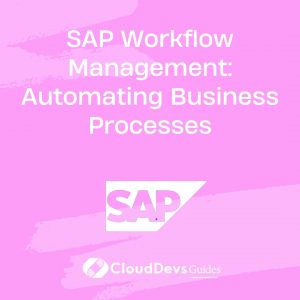SAP Workflow Management: Automating Business Processes
In today’s fast-paced business landscape, efficiency is everything. With the rise of digital transformation, companies are constantly seeking ways to streamline their operations, reduce costs, and improve productivity. One of the most effective ways to achieve these goals is through workflow management systems. And when it comes to enterprise-level workflow management, SAP stands out as a leader in the field.
SAP, short for Systems, Applications, and Products, offers a comprehensive suite of software solutions designed to optimize business processes across various industries. Among its many offerings, SAP workflow management tools empower organizations to automate and orchestrate their workflows, enabling smoother operations and faster decision-making.
1. What is SAP Workflow Management?
SAP workflow management is a module within the SAP ecosystem that allows businesses to design, execute, and monitor workflows across different departments and functions. These workflows are defined as sequences of tasks or activities that need to be completed to achieve a specific business objective. By automating these workflows, organizations can eliminate manual interventions, reduce errors, and ensure consistency and compliance.
2. Key Features and Benefits
2.1. Process Automation:
SAP workflow management automates repetitive tasks and standardizes processes, reducing the need for manual intervention. This automation not only saves time but also minimizes the risk of errors and ensures tasks are completed efficiently.
2.2. Centralized Visibility and Control:
With SAP workflow management, organizations gain centralized visibility into their business processes. They can track the progress of workflows in real-time, identify bottlenecks, and take proactive measures to optimize performance. Additionally, managers have greater control over approvals, escalations, and exceptions, enabling smoother operations.
2.3. Integration Capabilities:
SAP workflow management seamlessly integrates with other SAP modules and third-party applications, allowing for end-to-end process automation. Whether it’s procurement, finance, human resources, or supply chain management, SAP workflow management can streamline workflows across the entire enterprise.
Conclusion
In conclusion, SAP workflow management is a powerful tool for automating business processes and driving operational excellence. By leveraging SAP’s robust features and capabilities, organizations can streamline workflows, reduce costs, and improve productivity. Whether it’s manufacturing, banking, healthcare, or any other industry, SAP workflow management offers a scalable and customizable solution to meet the unique needs of modern enterprises.
To learn more about SAP workflow management and its benefits, check out the following resources:
- [SAP Official Website](https://www.sap.com/products/business-workflow-management.html)
- [SAP Workflow Management: A Comprehensive Guide](https://www.sap.com/documents/2019/09/64f3b847-297d-0010-87a3-c30de2ffd8ff.html)
- [Case Study: Streamlining Business Processes with SAP Workflow Management](https://www.sap.com/documents/2019/09/5b1d3186-507d-0010-87a3-c30de2ffd8ff.html)
With SAP workflow management, organizations can automate their way to greater efficiency and success in today’s digital economy.
Table of Contents









